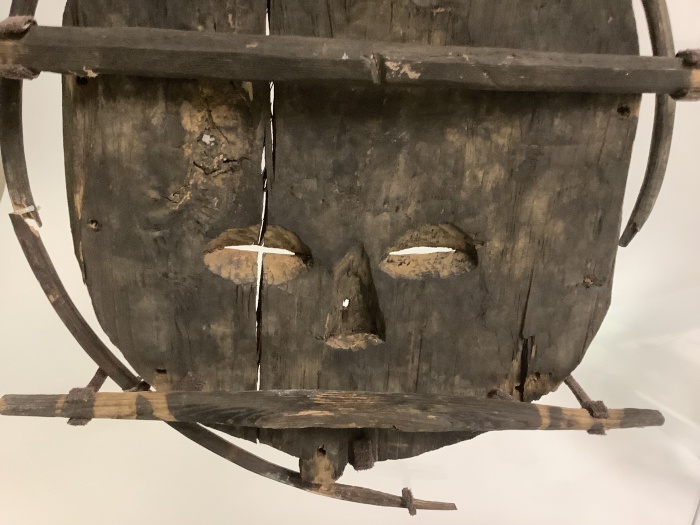Bite (to) — Kegluku
Kinam kegllruma una pRaanikaq. – Someone must have bitten this cookie.

Photo: Back of a wooden plank mask showing the bite bar, Koniag, Inc. Collection, Karluk One, AM193.
The Alutiiq word kegluku, to bite, comes from the root kege-. This root is commonly used to make words that describe eating—like taking a bite of seal meat or tearing a piece of dry fish with your teeth. It is also used to make words that mean to clench or gnash the teeth, to trap something between the teeth, or to crimp leather when sewing. In essence, kege-describes clamping together.
In classical Alutiiq society, dancers often grasped masks in their teeth. Many masks featured a bite bar or tooth grip. Wearers would clench their teeth on this long horizontal piece of wood attached to the back of a mask. The bar was typically aligned with the mask’s mouth and its ends lashed to a hoop encircling the mask. Some 19th century bite bar examples have a wide, flat area in the center, purposefully carved to fit in a dancer’s mouth.
Dancing with a heavy wooden mask clenched in your teeth required strength and balance. However, bite bars freed dancers’ arms for choreography. They also allowed performers to put on and take off masks rapidly, as some dances involved multiple masks. A collection of ancestral masks illustrates that bite bars were common on face-sized masks. In contrast, large, heavy masks were suspended from the ceilings of gathering spaces and dancers stepped behind them during performances. Some of these large masks also have bite bars. A line suspending the mask from the ceiling carried the weight of the mask and the bite bar allowed the dancer to move the carving during a performance.
In classical Alutiiq society, dancers often grasped masks in their teeth. Many masks featured a bite bar or tooth grip. Wearers would clench their teeth on this long horizontal piece of wood attached to the back of a mask. The bar was typically aligned with the mask’s mouth and its ends lashed to a hoop encircling the mask. Some 19th century bite bar examples have a wide, flat area in the center, purposefully carved to fit in a dancer’s mouth.
Dancing with a heavy wooden mask clenched in your teeth required strength and balance. However, bite bars freed dancers’ arms for choreography. They also allowed performers to put on and take off masks rapidly, as some dances involved multiple masks. A collection of ancestral masks illustrates that bite bars were common on face-sized masks. In contrast, large, heavy masks were suspended from the ceilings of gathering spaces and dancers stepped behind them during performances. Some of these large masks also have bite bars. A line suspending the mask from the ceiling carried the weight of the mask and the bite bar allowed the dancer to move the carving during a performance.
